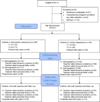A pilot study of a primary prevention curriculum to address preschool behavior problems
- PMID: 23897498
- PMCID: PMC3778445
- DOI: 10.1007/s10935-013-0316-1
A pilot study of a primary prevention curriculum to address preschool behavior problems
Abstract
Behavior problems among preschool children are common. They are important targets for intervention because early externalizing problems and self-regulation issues tend to persist without appropriate attention, and can affect later mental health and school achievement outcomes. However, few preschool curricula addressing social and emotional development exist, and evidence for effects are mixed. In this study, the Second Step Pre/Kindergarten Social and Emotional Learning curriculum was adapted and tested in a small cluster randomized pilot study of community preschool classrooms to determine if it could improve outcomes in: (1) individual children's teacher-rated behavior problems and prosocial skills; (2) classroom climate (classroom interactions and two measures of disruptive behavior); and (3) teacher interaction skills. Year 1 outcomes were modest and were accounted for by baseline differences. In Year 2, classroom climate, measured by independent observers, differed significantly in intervention classrooms, largely because of declines in control classrooms, and there was some evidence for better teacher interaction skills in intervention classrooms. The pattern of effects suggests important impacts on classroom quality worth investigating in a larger study. Both fidelity and implementation rates, as well as positive teacher responses to the curriculum, indicate potential for widespread adoption.
References
-
- Alkon A, Ramler M, MacLennan K. Evaluation of mental health consultation in child care centers. Early Childhood Education Journal. 2003;31:91–99.
-
- Arnett J. Caregiving in day-care centers. Does training matter? Journal of Applied Developmental Psychology. 1989;10:541–552.
-
- Baker JA, Kamphaus RW, Horne AM, Winsor AP. Evidence for population-based perspectives on children's behavioral adjustment and needs for service delivery in schools. School Psychology Review. 2006;35:31–46.
-
- Bayat M, Mindes G, Covitt S. What does RTI (Response to Intervention) look like in preschool? Early Childhood Education Journal. 2010;37:493–500.
-
- Committee for Children. Second Step: Preschool Kindergarten Social/Emotional Learning Kit; Second Step PreK/Teacher Guide; Second Step Parent Guide. Seattle, WA: Committee for Children; 2002.
Publication types
MeSH terms
Grants and funding
LinkOut - more resources
Full Text Sources
Other Literature Sources


